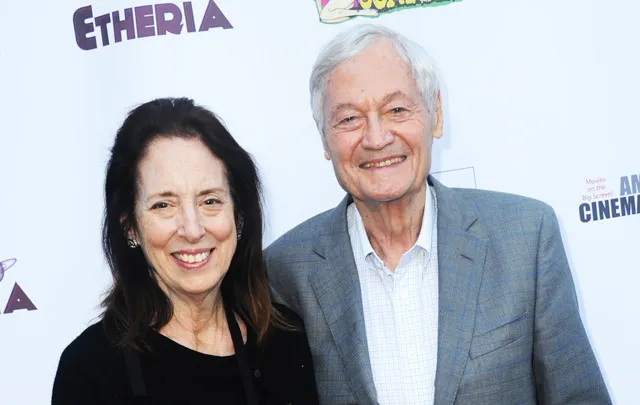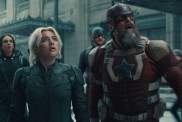ComingSoon.net got the opportunity to catch up with famed low-budget director and producer Roger Corman (Piranha) and fellow producer/spouse Julie Corman (Chopping Mall) to discuss the Shout! Factory docuseries Cult-Tastic: Tales from the Trenches with Roger and Julie Corman. The trailer for the series can be viewed in the player below!
RELATED: Exclusive: Roger Corman Biopic Has Already Shot a Corman Cameo
The 13-episode series created by Ashley and Robert Sidaway sees the Cormans draw upon their vast filmography from over 130 films spanning seven decades, sharing insightful stories and defining moments from their movies, recall talent and young filmmakers they fostered. The two also provide behind-the-scenes perspectives on how they produced some of the smallest budget films that went on to achieve box-office gold.
Throughout the series, the two recount working with iconic industry talent including Jack Nicholson (The Departed), Bryan Cranston (Breaking Bad), Ron Howard (Solo: A Star Wars Story), James Cameron (Avatar), William Shatner (Star Trek), Martin Sheen (Grace and Frankie), Joe Dante (Nightmare Cinema), Jamie Lee Curtis (Halloween), Tommy Lee Jones (Ad Astra), Angie Dickinson (Dressed to Kill), Francis Coppola (The Godfather), Will Ferrell (Holmes & Watson) and Sandra Bullock (Bird Box), among many others.
The two made an arrangement with Shout! Factory to handle their library of almost 400 films and the series is the first original aspect to spawn from it and that delving into the past was emotionally rewarding for the two.
“What it is essentially, it’s Julie and me talking about our films and showing the films in conjunction with our comment and whatever we can remember or make up as it were, and some information on the films,” Roger said. “The most interesting parts of it were the problem pictures. If it goes smoothly there isn’t much to say, we started on schedule/on time and we finished on schedule. It’s the problem pictures, as Julie said. She did a car chase in a garage.”
“This is just supposed to be about our film library, so not American International Pictures,” Julie said. “It was just a lot of interviews and dredged up a lot of memories, some great and some terrible. It rained 11 out of 15 days. We did a car chase in the garage, that was a lot of fun. We did what we could to have a lot of squeaking tires and wheels flying off, but there was nothing we could do, it was raining and we had to shoot. Then I also shot a film in the desert where it wasn’t supposed to rain at all and it rained more than half the days we were there. But the best things were, for example, when I think of Jonathan Demme, as we did a picture called Crazy Mama, one of his early epics. We listen to slightly different kinds of music so we fought over the music and we had a great time doing it. There were fun times like that and I really was working on songs. Me and Roger were splitting a distribution company worldwide, making 15 films a year, but I would generally go from one film to the next. So I was really more involved, more likely to be on the set, more likely to be making a lot of the even minor decisions, but it brought me in closer contact with the crews. The fun of it was finding people who, if we did have great challenges, we went on and worked, we’re always coming across someone else and were like ‘Oh my god, you won an Academy Award.'”
“Speaking of Jonathan Demme, there’s something that occurred that I think is actually fairly significant,” Roger said. “I remember when I was younger and I knew a number of young directors who sometimes would get an assignment to direct a picture that really didn’t appear to be that good. There were two ways to approach that. One was to say, ‘Well it’s a cheap little picture, I’ll take the money and move on.’ Or, you say ‘I’m going to do the best I can.’ For instance, Jonathan Demme made his debut as a director on a women in prison picture called Caged Heat and he said to me ‘I am to going to make the best women in prison picture ever made.’ The guys who said ‘I’ll just knock this thing off and take the money,’ they had no careers. The ones like Jonathan are much more talented and went on to have successful careers and he won an Academy Award.”

RELATED: Shout! Factory Purchases the Roger Corman Film Library
When thinking back on Demme’s Caged Heat, the two were reminded of Roger’s work in bringing Ingmar Bergman’s acclaimed period drama Cries and Whispers to the States as it struggled to find someone willing to put up the money to release it in North America. After getting the offer from Bergman’s agent, in which he’d be able to pull out of the film any time and could split the money 50/50 with Bergman, Roger told him “I’ll take that picture unseen immediately.”
“He accepted my offer, but then he insisted I see the picture, which of course I was going to see anyway,” Roger said. “Of course, I never pulled out and Cries and Whispers was the one that started us on more or less the arthouse distribution pictures from Bergman, [Federico] Fellini, [François] Truffaut, [Akira] Kurosawa and a number of others. So that became an important part of our distribution plan.”
“Getting them on the drive-in circuit is the part that I like and I think is so revealing of Roger is when people say, ‘How do I do what Roger Corman did?’ I think you have to think in the following ways,” Julie said. “Whispers has played out in theaters and it wasn’t really an arthouse picture. It was stunning, when I remember seeing it with Roger and we walked out of the theater and barely talked. So Roger thought of another way that it could bring in some revenue and that was to play in drive-ins. So he contacted Bergman and said, ‘It’ll have to be dubbed, and I don’t know how you feel about that.'”
After Bergman chose to dub the film himself, it hit theaters stateside and even played at a theater in Nashville as a double bill with Caged Heat, with Julie remarking “I don’t know what people though they were getting when they went to the drive-in but they got more than they bargained for.”
“The thinking was, we had played our regular hard-tops, as my sister called them, and it was the late fall,” Roger said. “The drive-ins weren’t getting very much attention because the season turned against it and there was a shortage of pictures that were available. We thought let’s give this a try, why not? A motion picture is a motion picture. We put it in the drive-in and it did average business and it was the only picture I know that everybody was delighted to do average business. Bergman sent me a note thanking me for bringing his picture to an audience he had never anticipated.
Roger had originally got his start as a distributor and producer with American International Pictures, where the roots were in old Hollywood and therefore were more tame before transitioning to the more graphic nature of New World. In looking at how to properly make the change over, he looked back at the different types of films that had worked at AIP and to plan out their distribution around it, beginning with The Student Nurses and continuing with The Big Doll House.
“I remember our head of distribution in the south who did New Orleans was Catholic,” Roger said. “Doll House did so much business when it opened on Friday when he met his son for mass no Sunday he lit a candle for the picture. A great analysis of what worked and it was just amazing, I think we went to at least 10 pictures, every picture was a success.”
“There was another aspect to the films, though, which was a kind of belief in liberal attitudes,” Julie said. “Speaking of New Orleans, we had a film manager named Larry and I had a black girl in this picture and he came down to the office and said, ‘Honey, you might have to re-cast this picture.’ He said ‘I can’t have a black girl in, I can’t film in the south.’ So I said, ‘Well that’s too bad Larry, because we’re going to have a black girl in it.’ So, the picture came out and it did very well, and then the next picture, my sister taught in East LA and I was like we’ve got to put a Hispanic story in here and I loved locations. So I went over and my sister took me around to her garage mechanic and this and that and I got all the locations set up with Hispanic girls. Larry came down to my office and he said, ‘Honey, you’re going to have to re-cast this picture. I can’t film this, you’ve got to put a black girl in here.'”
Long before Jason Blum made another successful habit out of it, the Cormans were best-known for producing low budget pictures and while Joe Dante has previously said that Roger is known for being a nice person, going over budget was not recommended on a film he was financing, as he would step in and have the talk with the filmmaker.
“I generally will meet with the director and the production manager and figure out what to do and very often I’ll put on a second unit, which enables us to catch up,” Roger said.
With his largely successful and iconic career, it’s no surprise that a biopic of the producer is in the works entitled The Man with Kaleidoscope Eyes on which mentee Dante is set to direct, who revealed exclusively to ComingSoon.net that he has already shot his cameo for the film.
“For some reason, Joe wanted to have the tennis sequence shot in advance, I think maybe because of getting older and I might not be able to play tennis anymore,” Roger said. “So we went up to a producer’s house who had a tennis court on his property and we went up and shot. It was very interesting because I was hitting the ball to nothing. They were throwing the ball to me and I was hitting it and there was nobody on the other side of the net.”
Though no one has been cast in the lead role yet, Bill Hader (It: Chapter Two) has done readings to portray Corman and is working to find the time in his schedule to star in the film. Roger had initially been skeptical of the reading, which took place in a theater so audiences could get a chance to watch the script be read aloud and it was a hit, a line around the block and filled to the brim.
“Bill was very good, he really caught the spirit of what I was doing,” Roger said. “He brought humor to it, so there was sort of the gravitas of making motion pictures, trying to do what you can, but also a little humor throughout it. Actually, I thought he was perfect for the role, it was just unfortunate that Joe wasn’t able to get the financing at that time.”
“We almost didn’t stay for the reading, we were going to go and have dinner,” Julie said. “So we did stay and Bill Hader opened and the first two words are, ‘Good morning, Francis.’ He had the entire audiences, because a lot of the people in the audience had worked with Francis, someone who was the story editor for 35 years, so she was there from the get-go or from the very early day. He just never stopped, he was amazing in the role.”
(Photo Credit: Getty Images)










